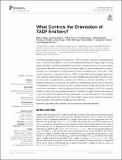Files in this item
What controls the orientation of TADF emitters?
Item metadata
| dc.contributor.author | Naqvi, Bilal | |
| dc.contributor.author | Schmid, Markus | |
| dc.contributor.author | Crovini, Ettore | |
| dc.contributor.author | Sahay, Prakhar | |
| dc.contributor.author | Naujoks, Tassilo | |
| dc.contributor.author | Rodella, Francesco | |
| dc.contributor.author | Zhang, Zhen | |
| dc.contributor.author | Strohriegl, Peter | |
| dc.contributor.author | Bräse, Stefan | |
| dc.contributor.author | Zysman-Colman, Eli | |
| dc.contributor.author | Bruetting, Wolfgang | |
| dc.date.accessioned | 2020-09-07T08:30:02Z | |
| dc.date.available | 2020-09-07T08:30:02Z | |
| dc.date.issued | 2020-09-04 | |
| dc.identifier | 269273865 | |
| dc.identifier | d101368c-055e-463c-9848-daa7373cc451 | |
| dc.identifier | 85091225453 | |
| dc.identifier | 000573812600001 | |
| dc.identifier.citation | Naqvi , B , Schmid , M , Crovini , E , Sahay , P , Naujoks , T , Rodella , F , Zhang , Z , Strohriegl , P , Bräse , S , Zysman-Colman , E & Bruetting , W 2020 , ' What controls the orientation of TADF emitters? ' , Frontiers in Chemistry , vol. 8 , 750 . https://doi.org/10.3389/fchem.2020.00750 | en |
| dc.identifier.issn | 2296-2646 | |
| dc.identifier.other | ORCID: /0000-0001-7183-6022/work/80257845 | |
| dc.identifier.uri | https://hdl.handle.net/10023/20572 | |
| dc.description | This work was funded by the EU Horizon 2020 MSC ITN “TADFlife” (Grant Agreement No. 812872) as well as by Deutsche Forschungsgemeinschaft (DFG, project no. Br 1728/20-1). ZZ acknowledges the financial support from Chinese Scholarship Council (CSC, 201606890009) for his PhD studies. | en |
| dc.description.abstract | Thermally-activated delayed fluorescence (TADF) emitters—just like phosphorescent ones—can in principle allow for 100% internal quantum efficiency of organic light-emitting diodes (OLEDs), because the initially formed electron-hole pairs in the non-emissive triplet state can be efficiently converted into emissive singlets by reverse intersystem crossing. However, as compared to phosphorescent emitter complexes with their bulky—often close to spherical—molecular structures, TADF emitters offer the advantage to align them such that their optical transition dipole moments (TDMs) lie preferentially in the film plane. In this report, we address the question which factors control the orientation of TADF emitters. Specifically, we discuss how guest-host interactions may be used to influence this parameter and propose an interplay of different factors being responsible. We infer that emitter orientation is mainly governed by the molecular shape of the TADF molecule itself and by the physical properties of the host—foremost, its glass transition temperature Tg and its tendency for alignment being expressed, e.g., as birefringence or the formation of a giant surface potential of the host. Electrostatic dipole-dipole interactions between host and emitter are not found to play an important role. | |
| dc.format.extent | 11 | |
| dc.format.extent | 13167304 | |
| dc.language.iso | eng | |
| dc.relation.ispartof | Frontiers in Chemistry | en |
| dc.subject | OLEDs | en |
| dc.subject | TADF | en |
| dc.subject | emitter orientation | en |
| dc.subject | Molecular orientation | en |
| dc.subject | Emitter-Host Interaction | en |
| dc.subject | QD Chemistry | en |
| dc.subject | DAS | en |
| dc.subject.lcc | QD | en |
| dc.title | What controls the orientation of TADF emitters? | en |
| dc.type | Journal article | en |
| dc.contributor.sponsor | European Commission | en |
| dc.contributor.institution | University of St Andrews. School of Chemistry | en |
| dc.contributor.institution | University of St Andrews. EaSTCHEM | en |
| dc.identifier.doi | 10.3389/fchem.2020.00750 | |
| dc.description.status | Peer reviewed | en |
| dc.date.embargoedUntil | 2020-09-04 | |
| dc.identifier.url | https://www.frontiersin.org/articles/10.3389/fchem.2021.632639/full | en |
| dc.identifier.grantnumber | 812872 | en |
This item appears in the following Collection(s)
Items in the St Andrews Research Repository are protected by copyright, with all rights reserved, unless otherwise indicated.

